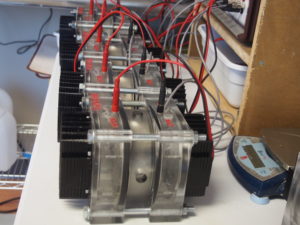Beton performs concrete testing in the lab and the field.
Durability-related tests

Unlike compressive strength, durability isn’t an intrinsic property of concrete. Durability makes sense only in the context of the exposure conditions.
Water penetration is directly or indirectly the cause of the majority of disintegrations in concrete and the degree to which water penetration is permitted by the texture of any concrete is a direct measure of its strength and endurance. —Concrete Engineers’ Handbook, 1918
Indeed, durability often relates to how readily water and ions can migrate into the concrete. Beton performs four different durability-related tests in our laboratory.
Let us help you decide which test(s) could be the most practical and informative for your project.
- ASTM C1202, Standard Test Method for Electrical Indication of Concrete’s Ability to Resist Chloride Ion Penetration, is sometimes known as the “Rapid Chloride Permeability” or “Coulomb” test. It measures the electrical charge passed in 6 hours under a constant 60 V.
- ASTM C1556, Standard Test Method for Determining the Apparent Chloride Diffusion Coefficient of Cementitious Mixtures by Bulk Diffusion, measures the apparent diffusion coefficient of the concrete. It requires a lengthy exposure period.
- ASTM C1876, Standard Test Method for Bulk Electrical Resistivity or Bulk Conductivity of Concrete, correlates well with ASTM C1556, but is a much more rapid test.
- NT Build 492, measures a non-steady state chloride diffusion coefficient.
Nondestructive testing
Nondestructive tests can be used on their own, as part of a forensic investigation, or simply to guide the location of cores. After all, you don’t want to cut through reinforcement or posttensioning tendons!
Beton conducts
- Static plate load tests
- MIRA ultrasonic tomography
- Ultrasonic pulse velocity
- Bond pull-off tests
